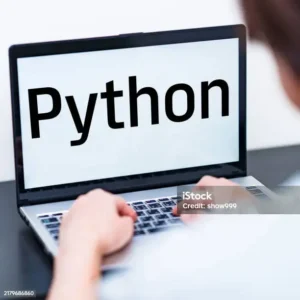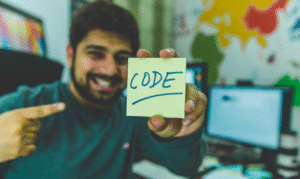
You’ve Googled “most asked Python interview questions” five times this week, but still end up with a random PDF or a boring Quora thread. Sound familiar? 2025’s Python interviews are sharper, faster, and less forgiving. But here’s the good news: you don’t need every question ever asked. Just the right ones.
This blog has all the Python interview questions you actually need to practice, explained simply, with curious readers in mind. Go ahead, scroll a little. This might just be the prep you didn’t know you needed.
Top 10 Python Interview Questions That Get You Hired
Crack Python, and you’ve cracked half the code interview battle; that’s what hiring managers across India are echoing in 2025. Python has become one of the top 3 most sought-after languages for technical interviews worldwide.
Google’s own Peter Norvig once said, “Python has been an important part of Google since the beginning.” So yes, knowing Python matters and but knowing how to answer Python interview questions? That’s what’ll land you the job.

1. What is Python?
Python is an interpreted and high-level programming language with clean syntax and easy readability. It is meant to assist developers in writing clean, rational code on projects of any scale.
Originally created by Guido van Rossum in 1991, Python supports multiple programming paradigms, like object-oriented and functional programming.
Tips:
Don’t merely refer to Python as “easy”. Say it’s powerful and beginner-friendly, which is exactly why companies like Google, Netflix, and Instagram use it.
Want to brush up a bit more before diving deeper? This beginner-friendly Python guide is a great way to warm up before the tougher questions roll in.
2. What are the key features of Python?
Some standout features of Python include:
- Readable & clean syntax (close to English)
- Interpreted language – no need to compile
- Dynamically typed – no need to declare variable types
- Extensive libraries & community support
- Cross-platform compatibility
- Supports OOP and functional programming
Tips:
You don’t have to list everything. Just highlight 3–4 features you’ve personally used or like, and relate it to real-world use that impresses interviewers more than memorising bullet points.
3. What are Python’s data types?
Python offers several built-in data types that help you work with different kinds of data:
- Numeric: int, float, complex
- Text: str
- Sequence: list, tuple, range
- Mapping: dict
- Set types: set, frozenset
- Boolean: bool
- Binary: bytes, bytearray, memoryview
Tips:
A confident answer highlights how these types are used, not just what they are. For example, say you use a list when data might change but a tuple when it shouldn’t. That shows understanding, not rote learning.
4. What is the difference between ‘is’ and ‘==’ in Python?
In Python, == checks if the values of two variables are equal, while is checks whether they are pointing to the same object in memory. For example, two lists can have the same content (== is True) but still have different objects (is is False).
Tips:
Many candidates fumble here. If you mention the memory reference concept with this, you’re already ahead of the curve.
5. What is the difference between a list and a tuple in Python?
The key difference is mutability:
- Lists are mutable, so you can freely update their contents, like add new items, delete some, or even modify existing ones.
- Tuples are immutable; that’s why, once defined, they can’t be changed.
Lists use square brackets ([]) while tuples use parentheses (()). Lists are used when your data needs to change; tuples are great when your data should stay constant.
Tips:
Mention performance! Tuples are slightly faster than lists and are often used for read-only data like fixed coordinates or configuration settings.
6. What is a Python decorator, and when would you use one?
A Python decorator is a tool that lets you modify a function’s behaviour without changing its original code. You can compare it to a situation when you add a filter to a picture; the background remains the same, but you make improvements.
I’d use a decorator when I want to keep things DRY (Don’t Repeat Yourself).
For example, in a web app, instead of adding login checks in every function, I can use a @login_required decorator once and keep the rest of the code clean and readable.
Tips:
Interviewers often look for how you’ve used decorators in real-world projects. Even a simple logging example can show that you understand abstraction and clean code principles.
7. Can you explain Python’s memory management model?
Python’s memory management is mostly hands-off thanks to reference counting. When no references are pointing to an object, it’s cleared from memory automatically.
For more complex cases like circular references, Python uses its garbage collector to clean up what the reference count can’t.
As developers, we don’t often manage memory directly, but understanding this model helps when we’re working on apps that run for hours or even days.
Tips:
Don’t just say, “Python handles memory automatically.” Add that you’re aware of concepts like reference counting and garbage collection.
8. What is the Global Interpreter Lock (GIL) in Python?
The Global Interpreter Lock, or GIL, is a mechanism in CPython (the default implementation of Python) that makes sure only one thread runs Python bytecode at a time. So even if your computer has 8 cores, Python still runs one thread at a time for CPU-bound tasks.
It’s mainly there to make memory management safe, but yes, it also limits true multi-threading.
Tips:
Always mention that the GIL affects multi-threading in CPU-heavy operations, not I/O tasks. That distinction shows you know your stuff.
9. How do you handle exceptions in Python, and why is it important?
In Python, we use try-except blocks. I mostly use it to catch runtime issues like missing files or wrong user inputs, without halting the program.
What I love is the flexibility: I can use else to run logic when things go right, and finally, for any clean-up, regardless of the outcome.
Why is it important? Since mistakes are unavoidable. And it is not an option to shut down the entire program.
Exception handling makes sure that your code behaves intelligently in terms of responding to a botched API call or a strange form entry, rather than collapsing.
Tips:
Want to stand out? Talk about raising custom exceptions for clearer debugging, as interviewers love that.
10. What are Python’s limitations?
Like any language, Python has its limits. It’s not lightning-fast, so when it comes to building something like a game engine or a super-optimised mobile app, it’s not the first pick. Its dynamic typing and higher memory usage also make it a less suitable choice for resource-tight applications. But for most use cases like automation, backend dev, or data analysis, Python is more than enough.
Tips:
It is not a sin to say the downsides; interviewers love it when you provide a balanced response. Just make sure you discuss how Python compensates for its shortcomings in an actual scenario.
Many candidates stumble on common Python interview questions, not because they’re hard, but because the basics weren’t strong enough. Our list of free Python courses can fix that for good.
5 Mistakes to Avoid in Python Interviews

You don’t need to be a Python genius to crack an interview; you just need to be prepared, clear-headed, and confident. Many Python interview questions are designed to test your basics, not trick you. Yet, it’s the common mistakes that catch most people off guard. Let’s help you walk in prepared and walk out smiling.
1. Mugging Up Without Understanding
Yes, we’ve all been guilty of rote learning at some point, but interviewers can sense when you’re rattling off something from a prep book. Python is known for its readability and simplicity; your answers should reflect the same. If you describe Python as “interpreted and dynamically typed” but can’t explain what that means in your own words, it’s a red flag.
Strategy to follow
Focus on grasping the logic. Always think about why something works, not just how. Try breaking it down in your own words as if you’re explaining it to a friend who’s new to programming.
2. Skipping the Basics Because They Seem Too Easy
Believe it or not, many interviews begin with questions like “What is a tuple?” or “What’s the difference between a list and a set?” Candidates often underestimate these and end up fumbling.
Basics aren’t basic in interviews. They’re foundational.
Strategy to follow
Go back to your roots. Revise the simple stuff. Most Python interview questions start from there!
3. Not Practising Out Loud Before the Interview
You might feel confident in your Python knowledge, but confidence inside your head doesn’t always translate well in an interview room. When the pressure is on and someone’s watching, even simple answers can suddenly slip your mind.
You’ll start saying “umm…” or giving half-baked answers that show uncertainty.
Strategy to follow
Rope in a cousin or a roommate and ask them to rate your answers like reality show judges. Fun for them, confidence boost for you.
Bonus: If they understand your answer, your explanation is probably rock solid.
4. Being Either Too Shy or Too Hard to Impress
In interviews, some folks barely speak up, keeping answers too short and safe. Others go the opposite way, overloading every response with big words and buzzwords they hardly understand.
Both styles miss the mark. Playing it too safe makes you forgettable, and overselling makes you look unprepared.
Strategy to follow
Keep it balanced. Talk about what you really know and where you’ve actually used it, even if it’s a college project.
If you mention something like pandas, be ready to explain it in your own words.
5. Skipping Questions at the End
This is the most underestimated part of the interview. When they ask, “Do you have any questions for us?” and you say, “Nothing,” it signals disinterest.
Interviews are a two-way street, and this is your moment to connect beyond just Python.
Strategy to follow
Ask something thoughtful about how the company uses Python or what learning opportunities they offer. It makes you come across as invested and proactive, two qualities every hiring manager loves.
Read More: Top 20 Selenium Automation Testing Interview Questions for QA
Before you step into the hot seat, watch someone else take it first. This mock Python interview below is like a test run, minus the sweaty nerves and judgmental panel. Give it a look, and thank yourself later.
Final Thoughts
You’ve practised the Python interview questions, survived the mock drills, and maybe even bribed your sibling to play fake HR. But let’s be real, no blog can fully capture the chaos of a real interview.
That moment when your brain blanks out on list comprehensions? Or when you say “tuple” but pronounce it like “toople”? Yeah, we’ve all been there.
But with practice, a good attitude, and the right prep (like this blog), you’re already on the winning track.
So, smile. You’ve got this far, and we’re rooting for you.
Now let us know, which Python question always throws you off? Or which one do you secretly hope doesn’t come up? Drop it in the comments and let’s laugh through the nerves together.
FAQs
1. What if I blank out during the interview? Should I panic?
Freezing up in interviews is totally normal. Even the most confident coders blank out when the spotlight hits. The trick is to shift your mindset from “performing” to “sharing.”
Think of the panel as peers, not judges and try explaining concepts to a friend or your reflection.
2. Can I crack interviews just by memorising Python interview questions?
Short answer: nope. Interviews test your understanding, not just recall.
Even if you go through a hundred Python interview questions, make sure you can explain them in your own words. That’s what really sticks.
3. Can I switch to Python from another language like Java or C++? Will interviewers judge me?
Not at all. In fact, many companies appreciate people who’ve explored multiple languages.
Just make sure you’ve practised Python-specific syntax and libraries so you don’t accidentally mix them up mid-answer.
4. Is Python alone enough to get a job in 2025?
Python is a strong start, no doubt. But if you really want to stand out in 2025, it’s smart to pair it with other skills like SQL, Git, a bit of DSA, or even some Flask or Django.






